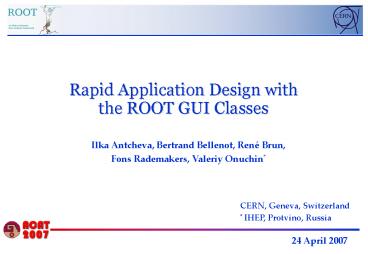Rapid Application Design with the ROOT GUI Classes - PowerPoint PPT Presentation
Title:
Rapid Application Design with the ROOT GUI Classes
Description:
'TGGroupFrame', gfr, 'SetTextFont(char*)'); fd- Connect('ColorSelected(Pixel_t)', 'TGGroupFrame', gfr, 'SetTextColor(Pixel_t)'); fClient- WaitForUnmap(fd) ... – PowerPoint PPT presentation
Number of Views:69
Avg rating:3.0/5.0
Title: Rapid Application Design with the ROOT GUI Classes
1
Rapid Application Design with the ROOT GUI Classes
Ilka Antcheva, Bertrand Bellenot, René Brun, Fons
Rademakers, Valeriy Onuchin
CERN, Geneva, Switzerland IHEP, Protvino, Russia
24 April 2007
2
Overview
- Main Features
- Benefits from Using CINT
- Application Design
- Signals Slots
- Scripting
- C Code Generation
- Dialogs
- GUI Builder
- Automatic Context Menus
- External Applications
- Conclusions
3
Main Features
- ROOT GUI classes form a rich and complete set of
widgets - Fully cross platform with the same look and feel
on either Unix, Linux, Windows and Mac OS X - Fully scriptable allowing fast prototyping via
the embedded CINT C interpreter - The GUI builder (under development) makes the
task of designing complex GUIs easier and faster - High level GUIs in ROOT the browser, tree
viewer, graphics editor, fit panel, session
viewer of PROOF, etc.
4
Benefits from Using CINT
- Prototyping via the CINT C interpreter
- Supports from simple sequence of statements to
complex C class and method definitions - Remove edit compile cycle
- Macros can be edited and re-executed
- Transparent interface to native C compiler to
run macro with native machine performance
root 0 .x myDialog.C root 1
root 0 .x myDialog.C root 1 .x myDialog.C
fText new TGTextEntry(fMain, new
TGTextBuffer(100)) fText-gtSetToolTipText("En
ter the label and hit Enter key")
fText-gtConnect("ReturnPressed()", "MyDialog",
this, "DoSetlabel()") fMain-gtAddFrame(fText,
new TGLayoutHints(kLHintsTop kLHintsLeft, 5,
5, 5, 5)) fGframe new TGGroupFrame(fMain,
"Last File") fLabel new TGLabel(fGframe,
"No Intut ") fGframe-gtAddFrame(fLabel, new
TGLayoutHints(kLHintsTop kLHintsLeft, 5, 5, 5,
5)) fMain-gtAddFrame(fGframe, new
TGLayoutHints(kLHintsExpandX, 2, 2, 1, 1))
// fText new TGTextEntry(fMain, new
TGTextBuffer(100)) // fText-gtSetToolTipText("En
ter the label and hit Enter key") //
fText-gtConnect("ReturnPressed()", "MyDialog",
this, "DoSetlabel()") // fMain-gtAddFrame(fText,
new TGLayoutHints(kLHintsTop kLHintsLeft, 5,
5, 5, 5)) fGframe new TGGroupFrame(fMain,
"Last File") fLabel new TGLabel(fGframe,
"No Intut ") fGframe-gtAddFrame(fLabel, new
TGLayoutHints(kLHintsTop kLHintsLeft, 5, 5, 5,
5)) fText new TGTextEntry(fGframe, new
TGTextBuffer(100)) fText-gtSetToolTipText("En
ter the label and hit Enter key")
fText-gtConnect("ReturnPressed()", "MyDialog",
this, "DoSetlabel()") fText-gtResize(150,
fText-gtGetDefaultHeight())
fGframe-gtAddFrame(fText, new TGLayoutHints(kLHints
Top kLHintsLeft, 5, 5, 5, 5))
fMain-gtAddFrame(fGframe, new TGLayoutHints(kLHints
ExpandX, 2, 2, 1, 1))
5
Application Design
- Map user requirements and logically organize the
GUI - Application window is handled by TGMainFrame
- Select widgets from ROOT GUI classes
- Layout the GUI components
- Parent-children relationship
- Different layout managers
- Program them to perform actions
- Signal/slot mechanism
- Conventional model of event processing
- Run and validate or iterate to improve
6
Signals Slots
- Signal/Slot communication mechanism is integrated
into ROOT core by TQObject, TQConnection, TQClass - Uses dictionary information and the CINT
interpreter to connect signal methods to slot
methods - Total independence
of the
interacting classes (easy programming)
7
Scripting
- Macros via the ROOT Object Browser
8
More Scripting
- TGTextEditor - basic editor for compiling and
executing macros
Drag Drop macros from the browser
9
C Code Generation
- Using ctrlS any GUI can be saved as a C macro
file thanks to the SavePrimitive methods
implemented in all GUI classes. - The generated macro can be modified and executed
- It restores the complete original GUI and all
existing signal/slot connections
root 0 .x example.C
10
Dialogs
- Standard set of common dialogs
- Files selection (multiple files)
- Input dialog
- Message window
- Search dialog
- Print dialog
TGFileInfo fi new TGFileDialog(fClient-gtGetDefaul
tRoot(), this, kFDOpen,fi) if
(fi.fMultipleSelection fi.fFileNamesList)
TObjString el TIter next(fi.fFileNamesList)
while ((el (TObjString ) next()))
new TFile(el-gtGetString(), "update") else
if (fi.fFilename) new TFile(fi.fFilename,
"update")
11
More Dialogs
// Change background color via color
selector. TGFrame fr TGColorDialog cd
GetGlobalColorDialog() cd-gtSetCurrentColor(fr-gt
GetBackground()) cd-gtConnect("ColorSelected(Pix
el_t)", "TGFrame", fr,
ChangeBackground(Pixel_t)") fClient-gtWaitForUnm
ap(cd) TQObjectDisconnect(cd)
// Change text font via font selection
dialog. TGGroupFrame gfr TGFontDialog fd
GetGlobalFontDialog() TGResourcePool rc
gcfClient-gtGetResourcePool() TGGC gc
rc-gtGetGCPool()-gtFindGC(fr-gtGetNormGC())
TGFont font 0 Font rc-gtGetFontPool()-gtFind
Font(fr-gtGetFontStruct()) fd-gtSetColor(gc-gtGetF
oreground()) fd-gtSetFont(font)
fd-gtConnect("FontSelected(char)",
"TGGroupFrame", gfr, "SetTextFont(char)")
fd-gtConnect("ColorSelected(Pixel_t)",
"TGGroupFrame", gfr, "SetTextColor(Pixel_t)")
fClient-gtWaitForUnmap(fd) TQObjectDisconnec
t(fd)
12
Complex Dialogs
13
GUI Builder
- Visual design without coding
- Design process
- Mainly based on Drag Drop
- Flexible layout settings
- Ends up as C source code reflecting
parents-children relationship - Establish signal/slot connections and their
concrete implementation (to be done)
14
Automatic Context Menus
- Context sensitive popup menu
- Automatically generated by ROOT
- Gives direct access to class member functions
- Any context menu can be retrieved
- Can be extended with user- defined entries
TClass cl Graph-gtIsA() TList mnl
cl-gtGetMenuList()
15
External Applications
- TCanvas can be embedded into any 3rd party GUI
environment when it is possible to - Obtain a Window ID (XID on X11, HWND on Windows)
- Create a timer to handle ROOT events
- Forward events to the ROOT canvas
ROOT
16
Conclusions
- The ROOT GUI classes form a rich and powerful
scriptable cross-platform GUI library - Solid basis for the development of additional
GUIs help browser, object editors, fit panel,
event displays - The GUI builder makes designing GUIs easier
- Easy application distribution by storing the
GUIs with data in the same ROOT file - The future - to provide users with access through
multiple interfaces from any location, with any
device at any time.































